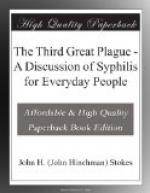+Effect of Mercurial Treatment on the Blood Test.+—The effect of mercury on the Wassermann blood test for syphilis should also be generally understood. In many cases it is possible, especially early in the disease, by a few rubs of mercurial ointment, or a few injections of mercury, or even in some cases by the use of pills or liquid medicine, to make a positive blood test for syphilis negative. But this negative test is only temporary. Within a short time, usually after treatment is stopped, the test becomes positive again, showing that the mercury has not yet cured, but simply checked, the disease, and that it may at any time break out again or do internal damage. It must be understood that a negative blood test just after a patient has been taking mercury has no meaning, so far as guaranteeing a cure is concerned. It is only the blood test that is repeatedly negative after the effect of mercury wears off, which shows the disease is cured. Yet many a syphilitic may and does think himself cured, and may marry in good faith, or be allowed a health certificate, only to become positive again. He may then develop new sores without his knowledge even, and perhaps infect his wife, or may himself in later years develop some of the serious consequences of the disease.
Whenever one talks to a person who knows something about the advances in knowledge in the past few years about the treatment of syphilis, and goes into detail about mercury, the odds are two to one that he will be interrupted by the question, “But what about ’606’?” Before talking about salvarsan, or “606,” it is well to say here that this new drug, wonderful though it is, has in no sense done away with the necessity for the use of mercury in the treatment of syphilis. Mercury has as high a reputation and is as indispensable in the cure of syphilis today as it was four centuries ago. It has as yet no substitutes. We appreciate every day, more and more, how thoroughly it can be depended on to do the work we ask of it.[8]
[8] A drug known as the iodid of potash (or soda) is widely used in the treatment of syphilis, and especially of the late forms of the disease, such as gummas and gummatous sores. It has a peculiar effect on gummatous tissue, causing it to melt away, so to speak, and greatly hastening the healing process. So remarkable is this effect that it gives the impression that iodids are really curing the syphilis itself. It has been shown, however,




